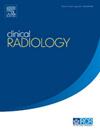基于 PET 的可解释瘤内和瘤周机器学习模型用于预测临床ⅠA 期非小细胞肺癌的内脏胸膜侵犯:一项双中心研究
IF 2.1
3区 医学
Q2 RADIOLOGY, NUCLEAR MEDICINE & MEDICAL IMAGING
引用次数: 0
摘要
目的本研究的目的是建立一个基于pet的机器学习模型来预测临床期IA期非小细胞肺癌患者的内脏胸膜浸润(VPI)。材料与方法回顾性分析两所医院接受18F-FDG-PET扫描的294例患者和69例患者。我们分别从总肿瘤体积(GTV)和包含肿瘤周围4、8和12 mm区域(GPTV4、GPTV8、GPTV12)的总肿瘤体积中提取基于pet的放射组学特征。然后利用机器学习算法分别建立了4个模型。采用受试者工作特征曲线(ROC)和决策曲线分析(DCA)对模型的性能进行评价。Shapley加性解释(SHAP)被用来解释机器学习(ML)模型和可视化变量预测。结果与GTV、GPTV4和GPTV12放射组学模型相比,基于随机森林(RF)的GPTV8放射组学模型在10个特征中表现出更好的预测性能,在训练集、内部验证集和外部验证集的AUC分别为0.879、0.846和0.745。SHAP方法的结果表明,GLRLM_ShortRunLowGreyLevel强调特征是VPI中最重要的因素。在患者水平上,SHAP力图为预测VPI提供了深入的理解。结论基于pet的基于机器学习的瘤内瘤周模型为肺腺癌患者VPI的术前预测提供了一种创新的工具。通过采用SHAP方法,临床医生可以更清楚地了解VPI的影响因素,从而提高临床对预后评估的决策。本文章由计算机程序翻译,如有差异,请以英文原文为准。
Explainable PET-based intratumoral and peritumoral machine learning model for predicting visceral pleural invasion in clinical-stage IA non-small cell lung cancer: A two-center study
AIM
The aim of this study was to develop a PET-based machine learning model for predicting visceral pleural invasion (VPI) in patients with clinical stage IA non-small cell lung cancer.
MATERIALS AND METHODS
A total of 294 patients and 69 patients from two institutions who underwent the 18F-FDG-PET scan were retrospectively analyzed. We extracted PET-based radiomics features from the gross tumor volume (GTV) and gross tumor volume incorporating peritumoral 4, 8 and 12 mm regions (GPTV4, GPTV8, GPTV12), respectively. Then four models were respectively established by using machine learning algorithms. The performance of the models was assessed by the receiver operating characteristic (ROC) curve and decision curve analyses (DCA). Shapley additive explanation (SHAP) was employed to explain the machine learning (ML) models and visualize variable predictions.
RESULTS
Compared with GTV, GPTV4, and GPTV12 radiomics models, the radiomics model based on GPTV8 using random forest (RF) among the 10 features demonstrated better prediction performance, with the AUC of 0.879, 0.846, and 0.745 in the training, internal validation, and external validation sets, respectively. The results of the SHAP method showed that the GLRLM_ShortRunLowGreyLevel Emphasis features were the most important factors in VPI. At the patient level, SHAP force plots provided a deep understanding for predicting VPI.
Conclusion
The PET-based intratumoral and peritumoral model based on machine learning offers an innovative tool for preoperative prediction of VPI in patients with lung adenocarcinoma. By employing the SHAP method, clinicians may gain a clearer insight into the factors contributing to VPI, which could enhance clinical decision-making of prognosis assessment.
求助全文
通过发布文献求助,成功后即可免费获取论文全文。
去求助
来源期刊

Clinical radiology
医学-核医学
CiteScore
4.70
自引率
3.80%
发文量
528
审稿时长
76 days
期刊介绍:
Clinical Radiology is published by Elsevier on behalf of The Royal College of Radiologists. Clinical Radiology is an International Journal bringing you original research, editorials and review articles on all aspects of diagnostic imaging, including:
• Computed tomography
• Magnetic resonance imaging
• Ultrasonography
• Digital radiology
• Interventional radiology
• Radiography
• Nuclear medicine
Papers on radiological protection, quality assurance, audit in radiology and matters relating to radiological training and education are also included. In addition, each issue contains correspondence, book reviews and notices of forthcoming events.
 求助内容:
求助内容: 应助结果提醒方式:
应助结果提醒方式:


